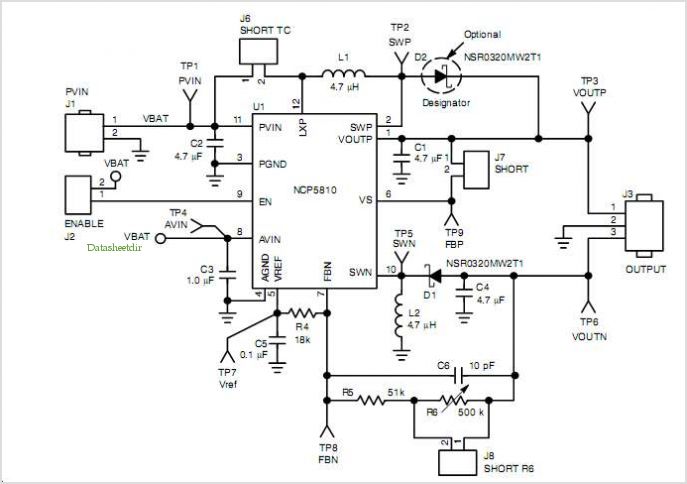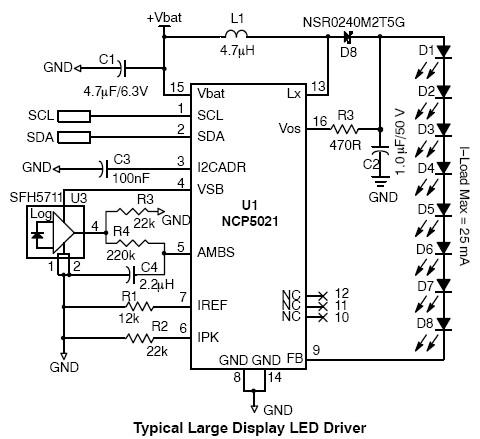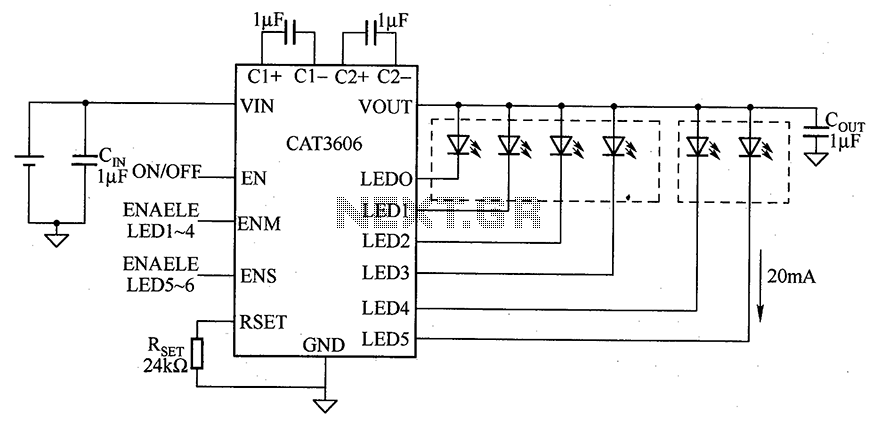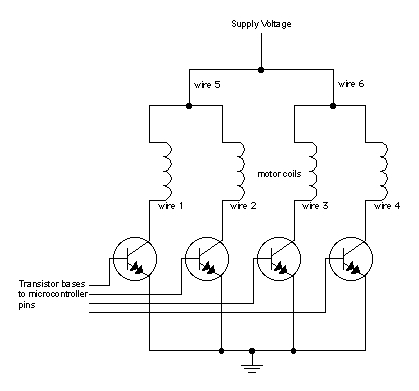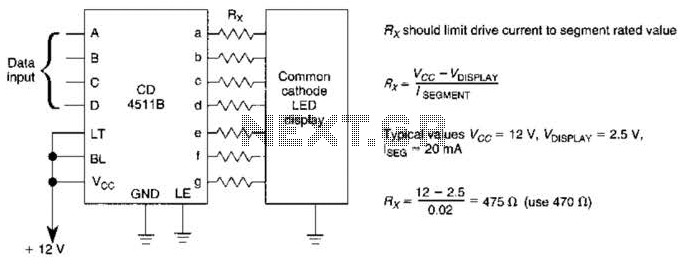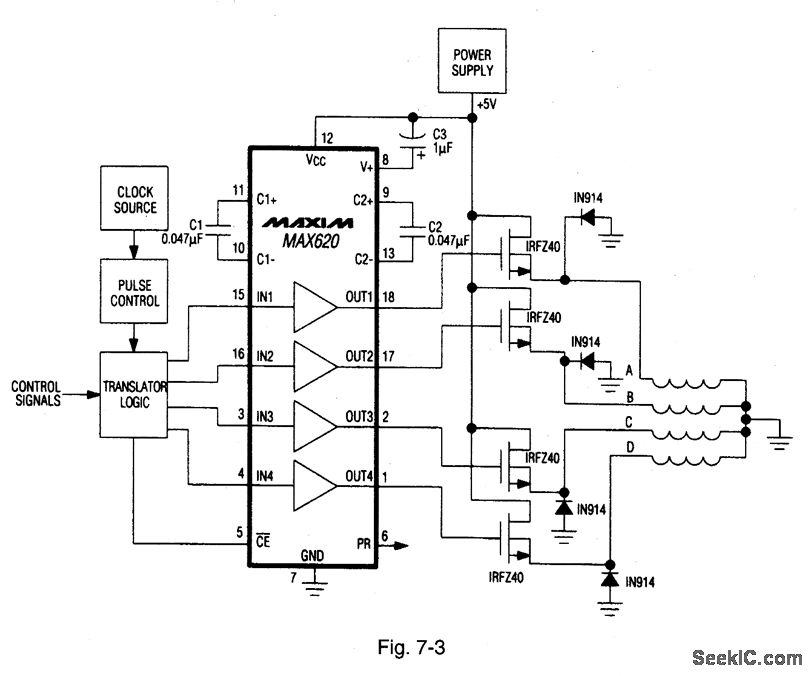
A Unipolar Stepper Motor Driver
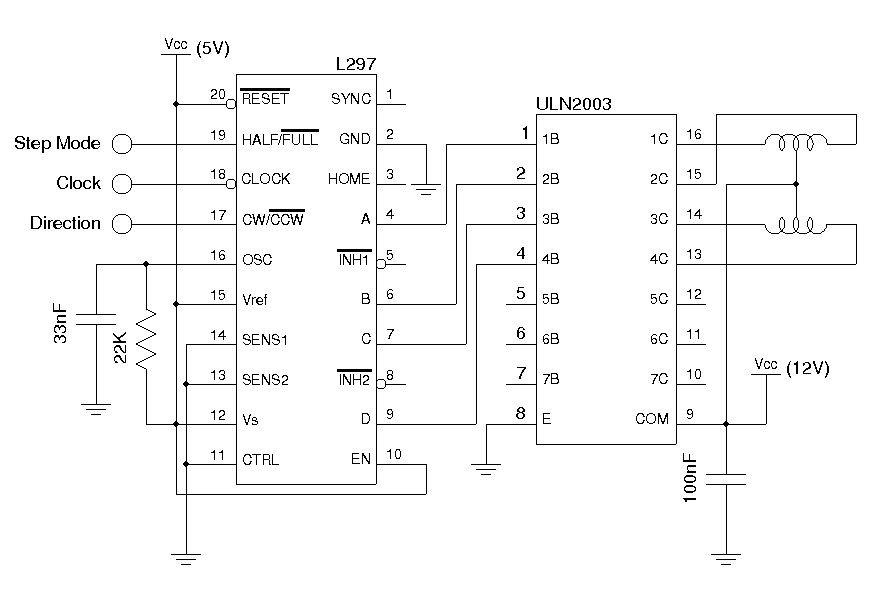
The drive circuits for unipolar stepper motors are typically straightforward. In their simplest configuration, a transistor or MOSFET is employed to control each section of the windings. The control signal must be supplied programmatically to the four windings of the unipolar stepper motor via a microcontroller unit (MCU). The programming can become complex when managing the stepping mode (e.g., half-stepping/full-stepping), stepping direction, and rotation speed. The L297 integrated circuit is utilized to generate the necessary stepping signals for the stepper motor. The SENSE, CONTROL, INH, and VRef pins can be used together to achieve finer pulse width modulation (PWM) current control and faster decay; however, these features are rarely required in most applications. Consequently, these features have been omitted by connecting the CONTROL and SENSE pins to ground and setting VRef to Vcc, while the INH pins remain unused, simplifying the circuit. For testing purposes, an Arduino MCU board was employed, using digital pin 10 to generate the required clock signal. For ease of use, the step mode and direction pins are grounded (indicating full step and counterclockwise rotation), though these pins can also be controlled programmatically. The program itself is straightforward, requiring only the generation of a clock signal. The following code utilizes the bit-banging method to produce a clock signal at approximately 250 Hz:
```cpp
int PIN_CLK = 10;
void setup() {
pinMode(PIN_CLK, OUTPUT);
digitalWrite(PIN_CLK, LOW);
}
void loop() {
digitalWrite(PIN_CLK, HIGH);
delay(2);
digitalWrite(PIN_CLK, LOW);
delay(2);
}
```
The circuit for driving unipolar stepper motors is designed to achieve simplicity while still allowing for effective control of motor functions. The use of transistors or MOSFETs as switches for each winding ensures that the current through the coils can be controlled with minimal components. The L297 IC serves as the core of the control system, generating necessary signals for stepping and direction.
In a typical configuration, the four windings of the unipolar stepper motor are connected to the outputs of the L297. The SENSE pin, when employed, allows for current sensing, enabling the implementation of current limiting features through PWM control. However, in this simplified design, the SENSE and CONTROL pins are grounded, which means that the motor operates without additional complexity, providing sufficient performance for many applications.
The Arduino MCU acts as the control unit, generating a clock signal that dictates the stepping of the motor. The choice of digital pin 10 for output is common, and the program structure allows for easy modifications should the user wish to implement different stepping modes or directions later on. The bit-banging method used in the code provides a straightforward way to control the timing of the pulses sent to the motor, ensuring consistent operation.
The circuit can be easily expanded or modified, allowing for additional features such as microstepping or more complex control algorithms if needed in future applications. The design is versatile and can serve as a foundational platform for various robotics and automation projects involving unipolar stepper motors.The drive circuits for Unipolar stepper motors are usually very simple. In its simplest form, a transistor or MOSFET is used to drive each section of the windings. With this design, the control signal must be supplied programmatically to the four windings of the unipolar stepper motor via an MCU. The programming can become quite complex when the s tepping mode (e. g. half stepping/full stepping), stepping direction and rotation speed all need to be controlled. Basically, the L297 is used to generate the stepping signals needed by the stepper motor. The SENSE, CONTROL, INH and VRef pins can be used in tandem to provide finer PWM current control and faster decay. But in all but the most strict applications, these features are rarely needed. So I omitted these features by tying CONTROL and SENSE pins to the ground and set VRef to Vcc. The INH pins are left unused. This way the complexity of the circuit is greatly reduced. If you intend to use these pins, please refer to the following application note (AN470). To test this circuit, I used an Arduino MCU board and used digital pin 10 to generate the required clock signal.
For simplicity, the step mode pin and the direction pin are grounded (full step, counter clockwise) as seen in the picture below, but these two pins can also be controlled programmatically. The actual program is very simple, all we needed to do is to provide a clock signal. The following code used the bit-banging method to generate the clock signal at roughly 250 Hz. int PIN_CLK = 10; void setup() { pinMode(PIN_CLK, OUTPUT); digitalWrite(PIN_CLK, LOW); } void loop() { digitalWrite(PIN_CLK, HIGH); delay(2); digitalWrite(PIN_CLK, LOW); delay(2); }
🔗 External reference
```cpp
int PIN_CLK = 10;
void setup() {
pinMode(PIN_CLK, OUTPUT);
digitalWrite(PIN_CLK, LOW);
}
void loop() {
digitalWrite(PIN_CLK, HIGH);
delay(2);
digitalWrite(PIN_CLK, LOW);
delay(2);
}
```
The circuit for driving unipolar stepper motors is designed to achieve simplicity while still allowing for effective control of motor functions. The use of transistors or MOSFETs as switches for each winding ensures that the current through the coils can be controlled with minimal components. The L297 IC serves as the core of the control system, generating necessary signals for stepping and direction.
In a typical configuration, the four windings of the unipolar stepper motor are connected to the outputs of the L297. The SENSE pin, when employed, allows for current sensing, enabling the implementation of current limiting features through PWM control. However, in this simplified design, the SENSE and CONTROL pins are grounded, which means that the motor operates without additional complexity, providing sufficient performance for many applications.
The Arduino MCU acts as the control unit, generating a clock signal that dictates the stepping of the motor. The choice of digital pin 10 for output is common, and the program structure allows for easy modifications should the user wish to implement different stepping modes or directions later on. The bit-banging method used in the code provides a straightforward way to control the timing of the pulses sent to the motor, ensuring consistent operation.
The circuit can be easily expanded or modified, allowing for additional features such as microstepping or more complex control algorithms if needed in future applications. The design is versatile and can serve as a foundational platform for various robotics and automation projects involving unipolar stepper motors.The drive circuits for Unipolar stepper motors are usually very simple. In its simplest form, a transistor or MOSFET is used to drive each section of the windings. With this design, the control signal must be supplied programmatically to the four windings of the unipolar stepper motor via an MCU. The programming can become quite complex when the s tepping mode (e. g. half stepping/full stepping), stepping direction and rotation speed all need to be controlled. Basically, the L297 is used to generate the stepping signals needed by the stepper motor. The SENSE, CONTROL, INH and VRef pins can be used in tandem to provide finer PWM current control and faster decay. But in all but the most strict applications, these features are rarely needed. So I omitted these features by tying CONTROL and SENSE pins to the ground and set VRef to Vcc. The INH pins are left unused. This way the complexity of the circuit is greatly reduced. If you intend to use these pins, please refer to the following application note (AN470). To test this circuit, I used an Arduino MCU board and used digital pin 10 to generate the required clock signal.
For simplicity, the step mode pin and the direction pin are grounded (full step, counter clockwise) as seen in the picture below, but these two pins can also be controlled programmatically. The actual program is very simple, all we needed to do is to provide a clock signal. The following code used the bit-banging method to generate the clock signal at roughly 250 Hz. int PIN_CLK = 10; void setup() { pinMode(PIN_CLK, OUTPUT); digitalWrite(PIN_CLK, LOW); } void loop() { digitalWrite(PIN_CLK, HIGH); delay(2); digitalWrite(PIN_CLK, LOW); delay(2); }
🔗 External reference
